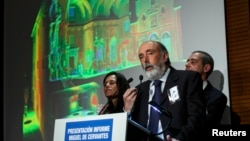Spanish scientists said on Tuesday that remains found under a Madrid convent are likely to include those of “Don Quixote” author Miguel de Cervantes, one of the world's most celebrated writers.
Nearly 400 years after his death, the quest to find Cervantes had led investigators deep into the sub-soil of a 17th century convent. Some of bones dug up in recent months almost certainly belong to the writer, they said.
“We believe that some of the remains of Miguel de Cervantes are among the fragments,” forensic anthropologist Francisco Etxeberria told a news conference.
Investigators may never be able to guarantee with absolute certainty that it was his body and DNA tests would be tricky, the experts said. Cervantes had a sister who is buried near Madrid, but only tiny bone fragments remain of her body.
Cervantes -- whose masterpiece about an errant, daydreaming knight and his faithful servant Sancho Panza has delighted readers around the world -- had requested to be buried in the convent.
The Trinitarian religious order had helped to pay a ransom to release him from slavery after he was captured by Moorish pirates.
Tomb lost during rebuilding
He died in 1616 -- the same week as William Shakespeare. But the exact location of his tomb was lost in a subsequent rebuilding of the convent.
Historians hope to establish a burial site for Cervantes, considered the father of the modern novel, to attract literary pilgrims and tourists. Madrid mayor Ana Botella said on Tuesday that authorities were looking into the possibility of opening up the site to visitors.
“We've contributed a little bit to our history today,” she said.
Investigators began their search almost a year ago in the cloistered baroque convent, still home to a dozen elderly nuns. They recently found bone fragments and as well as a dilapidated piece of a wooden coffin with the letters “M” and “C” on it.
None of the bones showed signs of the injuries Cervantes was known to have sustained during his life, including lesions to his left arm when he fought in the Battle of Lepanto in 1571, the experts said.
The Cervantes search takes place after a similar quest in Britain, where investigators found the remains of medieval monarch King Richard III in 2012 under municipal car park. He will be reburied in a ceremony next week.






